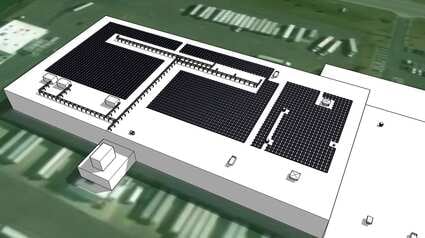If you look at enough aerial photos of businesses with rooftop solar photovoltaic (PV) installations, you’ll quickly discover that the look and layout of these projects vary drastically in size, shape and style. It’s also likely that you’ll start formulating questions such as, “why didn’t they use the whole roof?” or “why did they use that part of the roof?”, or even, “why is the system shaped like that?”.
When it comes to figuring out the ideal layout of solar panels to make an effective rooftop system, it’s as much an art form as it is a technical exercise. There are many important factors that must be considered to create the most effective system for the customer.
What type of solar mount is ideal for the project?
The two most widely used rooftop mounting systems are the more traditional single-azimuth (also known as South-facing), and a more recently developed system called dual-tilt (aka East-West). Each has its own benefits and attachment methods, so we start the project with modeling software to determine:- The building’s orientation, relative to South: Ideally, when viewed from above, a building’s available roof space will have a predominate axis that runs either North-South or East-West. This scenario allows the most flexibility for deciding what type of mount will be used.
- The pitch (slope) of the roof: Many industrial facilities have roofs that are relatively flat, with just enough slope to allow for water drainage. A flat roof is an ideal candidate for a ballasted (weighted) mounting system, whereby the solar PV system is simply affixed in place using concrete blocks. For roofs with greater pitch, the system will need to be held in place with mechanical anchors that attach to the structural system below.
What is the composition and integrity of the roof structure?
Not all rooftops are created equal when it comes to the physical composition of the roofing material and the strength of the roof structure. There are a multitude of materials and methods for building a roof so each prospective project site must be analyzed to determine the additional weight-bearing capacity of the structure.What physical obstacles need to be considered?
The topography of commercial and industrial roofs often feature mechanical equipment and other components that are necessary for the building’s operations. Since two objects can’t occupy the same space on the roof’s surface, a solar PV system layout must be designed around existing and planned obstructions. These items commonly include HVAC systems, roof drains, vent and gas pipes, and conduits for electrical services. A proposed layout must continue to provide service and maintenance access for mechanicals. Of paramount importance is the shading implications that these physical obstructions impose. Solar panels don’t work as well if the sun isn’t fully shining on the entire surface, so shade considerations are studied at length throughout the design process.What is the optimum size of the overall system?
There are many factors that go into deciding the best size for each unique project. These project levers are determined by energy and site analyses and by understanding the customer’s goals and desires. For example, some system owners may want to offset as much of their monthly electric bill as possible, while others may be satisfied with something much less. Also, many large buildings do not need to devote the entirety of the available roof area for a solar system to significantly reduce the business’s electrical consumption from its utility company. Conversely, a small building may have activities that use lots of power and will only achieve a small offset at best, based on the size and available space of its roof.What policies has the local utility enacted regarding solar?
Utility companies have different policies when it comes to customer-sited solar PV generation. For example, net metering is a policy whereby a utility may pay its customer back any excess solar electricity it sends back to the grid. Some utilities will compensate the owner back at the same rate they pay for it, while others will not. These policies are important to understand upfront as they can have positive or negative effects on the project financials and can therefore change the desired system size and overall design.What is the size and output capacity of the modules themselves?
To answer this question, we need to think about another key component of the system: the inverter. While solar panels convert sunlight into electricity, the system needs an inverter to change direct current (DC) into the alternating current (AC) that runs most machinery and appliances. Inverters are highly complex pieces of equipment that require very exacting input in order to operate at peak efficiency. By selecting the right inverter size for the specific project, we can then determine the specific number of panels that will be needed in the system.
As you can see, there are many important factors to consider when designing a solar PV system. It’s not quite as easy as just “getting some solar panels” for your roof. If you’re exploring solar for your business, make sure you enlist the guidance of an experienced solar developer so your company reaps the most benefit from your installation – now, and in the years to come.
